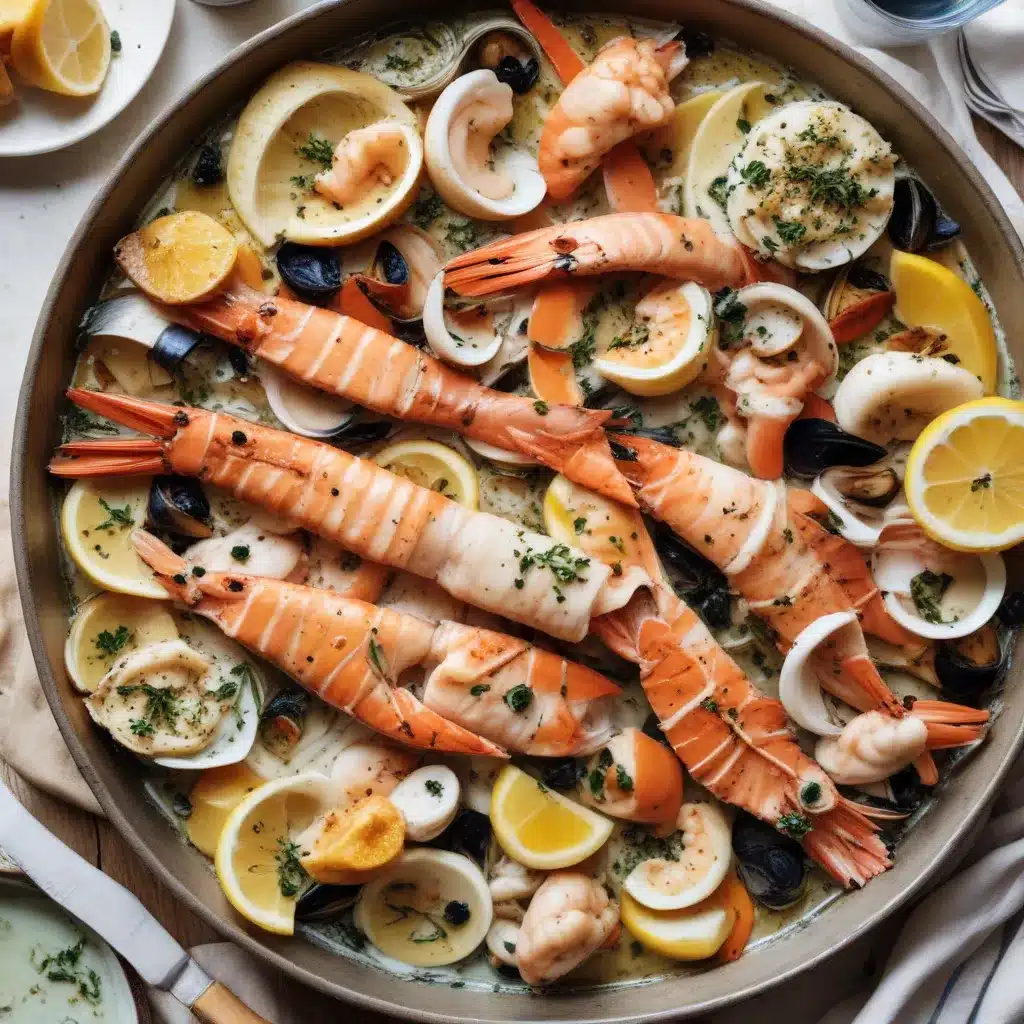
As an expert seafood dining writer for Fish Tales Café, I’m thrilled to share my insights on the art of baking delectable seafood dishes. Whether you’re a seasoned home chef or a novice cook, mastering the nuances of seafood baking can elevate your culinary repertoire and delight your taste buds.
Key Ingredients for Seafood Baking
At the heart of any successful baked seafood dish lies the careful selection of high-quality seafood ingredients. While a wide variety of fish and shellfish can be baked, some of the most popular choices include cod, salmon, halibut, shrimp, and scallops. Each seafood type has its own unique flavor profile and cooking requirements, so it’s essential to understand their distinct characteristics.
In addition to the seafood, the right combination of seasonings and spices can make all the difference. Common baking-friendly seasonings include garlic, lemon, dill, rosemary, and a variety of Creole or cajun blends. Incorporating these flavorful elements can add depth and complexity to your baked seafood dishes.
The baking techniques you employ will also play a crucial role in the final outcome. From classic oven-baking to innovative methods like broiling or en papillote (baking in parchment paper), understanding the nuances of each approach will help you achieve the perfect texture and doneness.
Preparation Considerations
Before you dive into the baking process, it’s essential to properly clean and prepare your seafood. Carefully removing any shells, bones, or unwanted parts, and ensuring the seafood is thoroughly patted dry, are crucial steps to set the stage for delicious results.
Precise measurement of ingredients, particularly when dealing with delicate seafood, can make or break a dish. Carefully measuring out spices, herbs, and any accompanying liquids or sauces will help you achieve the right balance of flavors.
Marinating seafood prior to baking can also work wonders, infusing the proteins with a blend of complementary seasonings and acids that tenderize the flesh and enhance the overall taste. Experimenting with different marinades, such as citrus-based or herb-infused varieties, can open up a world of flavor possibilities.
Baking Methods and Styles
One of the most classic and versatile baking techniques for seafood is oven-baking. By carefully controlling the temperature and cooking time, you can achieve perfectly flaky, moist, and evenly cooked results. Ensure your oven is preheated to the right temperature, typically between 375-425°F, and monitor the seafood closely to avoid overcooking.
Broiling is another excellent method for baking seafood, particularly for achieving a delightful caramelized crust. This high-heat cooking technique works particularly well with thicker cuts of fish or hearty shellfish like shrimp and scallops.
For a more delicate and flavorful approach, consider the en papillote (baked in parchment) method. By wrapping the seafood and accompanying ingredients in a parchment paper packet, you can create a self-basting environment that infuses the protein with mouthwatering aromas and juices.
Complementary Sides and Garnishes
Baked seafood dishes shine when paired with the right complementary sides and garnishes. Roasted or grilled vegetables, such as asparagus, Brussels sprouts, or roasted potatoes, can provide a delightful contrast to the seafood’s delicate flavor.
For starch options, consider serving baked seafood alongside fluffy rice, quinoa, or even a crusty baguette to soak up any flavorful juices.
Sauces and dips can also elevate your baked seafood creations. From a classic lemon-butter sauce to a zesty remoulade or a creamy béchamel, the right accompaniment can take your dish to new heights.
Flavor Profiles and Combinations
Seafood baking offers a canvas for endless flavor exploration. Pairing your chosen seafood with vibrant herbs like dill, basil, or cilantro can create a harmonious balance of freshness and richness.
Incorporating citrus elements, such as lemon, lime, or orange, can also lend a bright, acidic counterpoint to the natural sweetness of the seafood.
For those who enjoy a bit of heat, experimenting with spicy seasonings or a creamy cajun or creole sauce can introduce a delightful contrast of flavors and textures.
Dietary Accommodations
Baked seafood dishes can be easily adapted to cater to various dietary needs, including low-carb and gluten-free options. For a low-carb approach, consider serving your baked seafood over a bed of roasted vegetables or a cauliflower rice medley.
For gluten-free enthusiasts, opt for gluten-free breadcrumbs or almond flour as a coating, and ensure any accompanying sauces or marinades are also gluten-free.
Presentation and Plating
When it comes to baked seafood, the visual presentation can be just as important as the flavors. Showcase your culinary masterpiece by garnishing with fresh herbs, citrus wedges, or a drizzle of beurre blanc or pesto. Arrange the seafood and sides in a visually appealing manner, playing with color and texture to create a truly appetizing dish.
Storing and Reheating
Proper storage and reheating techniques are crucial for ensuring your baked seafood retains its freshness and texture. Always store cooked seafood in an airtight container in the refrigerator, where it can typically last for 3-4 days. When reheating, opt for gentle methods like the oven or a low-heat stovetop to avoid overcooking and drying out the seafood.
For longer-term storage, baked seafood dishes can also be frozen for up to 3 months. Just be sure to cool the seafood completely before freezing and thaw it in the refrigerator before reheating.
Mastering the art of baking seafood is a journey filled with endless possibilities. By understanding the key ingredients, preparation techniques, and flavor profiles, you can create a mouthwatering array of baked seafood dishes that will impress your family and friends. So, preheat your oven, gather your fresh seafood, and let’s embark on a flavorful culinary adventure together at Fish Tales Café!

